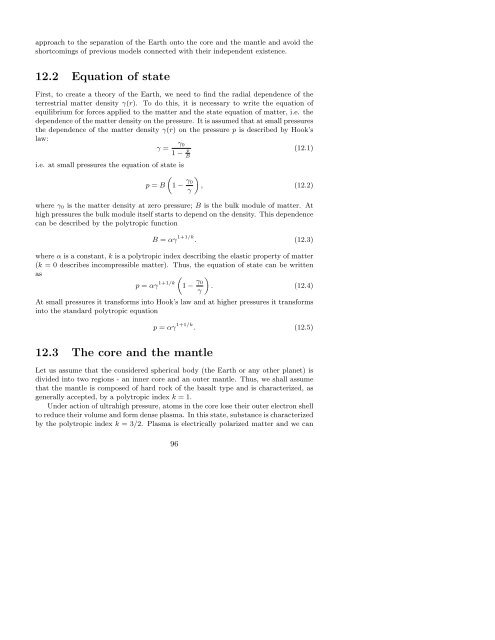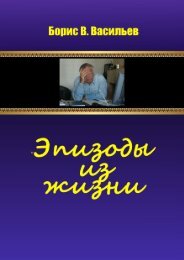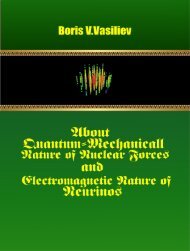VbvAstE-001
Book Boris V. Vasiliev Astrophysics
Book Boris V. Vasiliev
Astrophysics
Create successful ePaper yourself
Turn your PDF publications into a flip-book with our unique Google optimized e-Paper software.
approach to the separation of the Earth onto the core and the mantle and avoid the<br />
shortcomings of previous models connected with their independent existence.<br />
12.2 Equation of state<br />
First, to create a theory of the Earth, we need to find the radial dependence of the<br />
terrestrial matter density γ(r). To do this, it is necessary to write the equation of<br />
equilibrium for forces applied to the matter and the state equation of matter, i.e. the<br />
dependence of the matter density on the pressure. It is assumed that at small pressures<br />
the dependence of the matter density γ(r) on the pressure p is described by Hook’s<br />
law:<br />
γ =<br />
γ0<br />
1 − p (12.1)<br />
B<br />
i.e. at small pressures the equation of state is<br />
( )<br />
p = B 1 − γ0<br />
, (12.2)<br />
γ<br />
where γ 0 is the matter density at zero pressure; B is the bulk module of matter. At<br />
high pressures the bulk module itself starts to depend on the density. This dependence<br />
can be described by the polytropic function<br />
B = αγ 1+1/k . (12.3)<br />
where α is a constant, k is a polytropic index describing the elastic property of matter<br />
(k = 0 describes incompressible matter). Thus, the equation of state can be written<br />
as<br />
( )<br />
p = αγ 1+1/k 1 − γ0<br />
. (12.4)<br />
γ<br />
At small pressures it transforms into Hook’s law and at higher pressures it transforms<br />
into the standard polytropic equation<br />
p = αγ 1+1/k . (12.5)<br />
12.3 The core and the mantle<br />
Let us assume that the considered spherical body (the Earth or any other planet) is<br />
divided into two regions - an inner core and an outer mantle. Thus, we shall assume<br />
that the mantle is composed of hard rock of the basalt type and is characterized, as<br />
generally accepted, by a polytropic index k = 1.<br />
Under action of ultrahigh pressure, atoms in the core lose their outer electron shell<br />
to reduce their volume and form dense plasma. In this state, substance is characterized<br />
by the polytropic index k = 3/2. Plasma is electrically polarized matter and we can<br />
96













